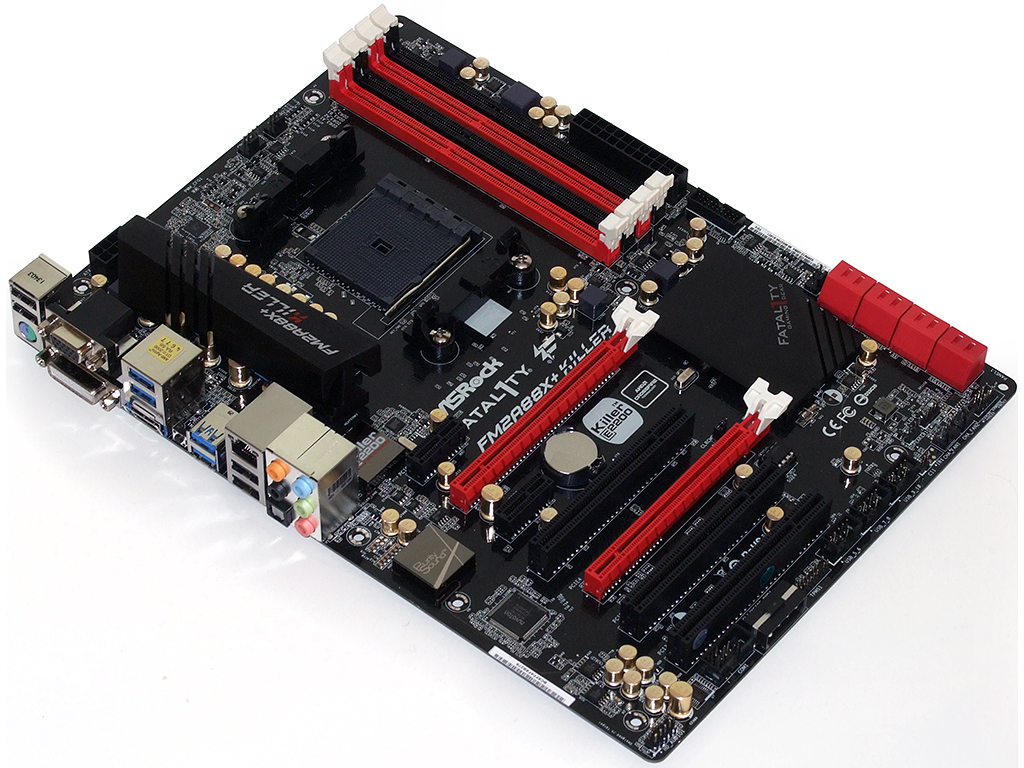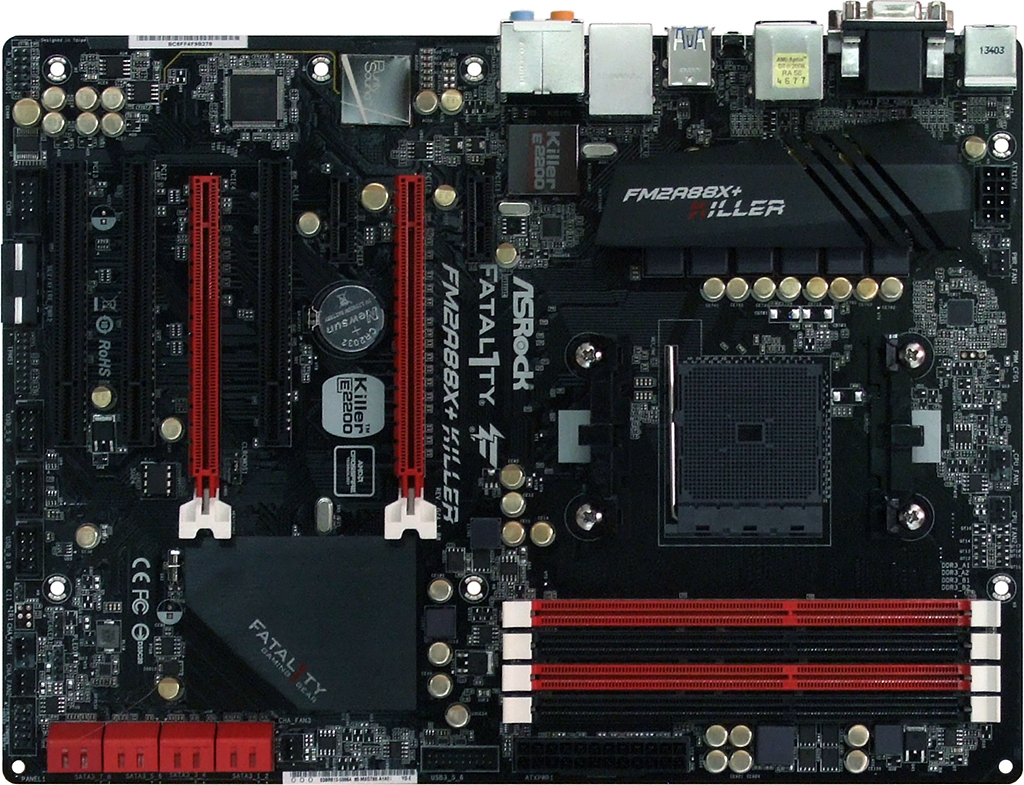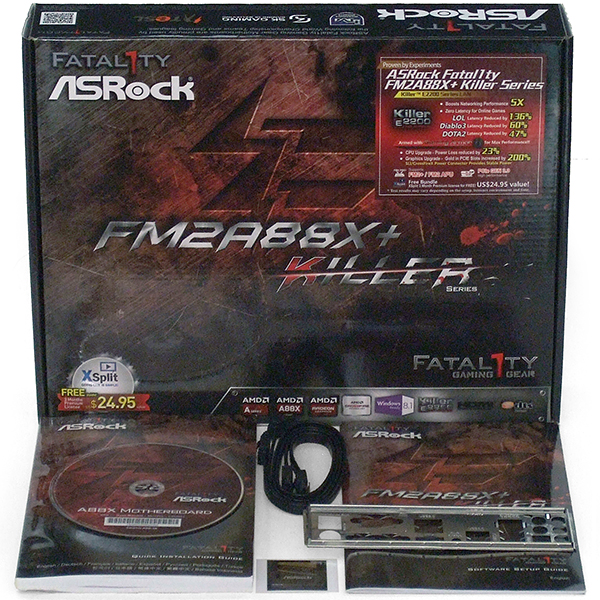Which A88X-Based Board Should You Buy For Your Kaveri APU?
ASRock FM2A88X+ Killer
Even though the A88X Fusion Controller Hub was released in concert with Socket FM2+, ASRock still sees the need to be clear by adding a plus symbol to the name of its FM2A88X+ Killer. The rest of the name lets us know right away that it’s equipped with a PCIe-based Killer E2205 GbE controller.
Other improved features include an extra pair of USB 3.0 ports via ASMedia’s ASM1042 controller and DTS Connect software for Realtek’s ALC1150 eight-channel audio codec. The extra ports are only needed because the A88X’s aging design supports only four ports natively.
Four USB 2.0 ports on the I/O panel take care of basic needs, such as keyboards and mice, while the even more outdated VGA output simply wastes space, since the same function could have been achieved through a DVI-I (rather than DVI-D) connector. The more flexible DisplayPort interface is sorely missing, though users of native 1080p displays might prefer the HDMI output.
ASRock doesn’t outfit the top of the board with a bunch of buttons, though it does add a CLR_CMOS switch to the I/O panel. Instead, we find a tidy collection of AMD-supported features, such as a single PCIe 3.0-capable x16 slot, a four-lane PCIe 2.0 slot in a x16-length connector, two USB 3.0 ports on an internal front-panel header, and eight SATA 6Gb/s ports carried forward to A88X from the older A85X FCH.
Missing are cost-adding PCIe switches that could have allowed the A88X chipset to support two cards in x8 slots using PCIe 3.0 signaling, though ASRock already knows that most of the cards able to benefit from such a configuration overpower AMD's mainstream APU. Whatever bandwidth the company makes available to a second graphics card should be suitable for most non-gaming needs, such as crypto-currency mining and additional display connectivity.
The FM2A88X+ Killer also has two single-lane PCIe 2.0 slots, though adding a graphics card will cover one of them. ASRock appears to favor legacy PCI in this design.
A replaceable BIOS IC simplifies repairs on a board that’s probably too entry-level to justify a dual-BIOS implementation. Other layout advantages include power and USB 3.0 connectors within easy reach of their corresponding cables. Our only criticism concerns the FP-Audio connector that’s shoved all the way into the bottom-rear corner. This isn't relevant to most folks, but we still review cases that lack the cable length to reach.
Get Tom's Hardware's best news and in-depth reviews, straight to your inbox.
We feel that two is the minimum number of SATA cables required to fill the needs of most entry-level builders. While we’re not pleased to see a manufacturer skate by on our bare minimums, that’s exactly the number of cables found in the FM2A88X+ Killer installation kit.
Current page: ASRock FM2A88X+ Killer
Prev Page Four Motherboards For AMD's Kaveri-Based APUs Next Page FM2A88X+ Killer Firmware-
gadgety To me the point of Kaveri is great graphics in a small package, thus the MB would have to be as small as possible. M-ITX is currently the smallest. Someone should bring out a NUC sized board for the Kaveri.Reply -
blackmagnum On the other side of the fence... Haswell+ Maxwell= performance/watt/buck. You're welcome.Reply -
ta152h The IO device is called PS/2, not P/S 2. It stands for Personal System/2, the IBM product line from 1987. Also, there's a chance there's a big performance gain from Catalyst 14.2, instead of 14.1. Another site did benchmarks comparing 13.6 and 14.2, and the difference was dramatic. It most likely was the somewhere in the 13.6 to 14.1 range, though. I thought the days of one motherboard having significantly faster memory timings than the other died with the IMCs. After being shocked at the horrible performance of the Kaveri, and the almost complete failure of it, between the driver update, and advantage the Asus has, it's clear AMD pulled another "Hawaii", and put their technology in the worst possible light by not packaging it with the proper associated support technologies. Considering the long development cycles for these devices, it's hard to understand how AMD couldn't figure out a proper cooler for the Hawaii, or have drivers degrade performance so much for Kaveri, that within a month or so they were able to increase performance so dramatically. And now, it's clear the memory performance optimizations were far from complete. And Kaveri was a delayed product. It boggles the mind that they consistently fail to find such obvious shortcomings, when everyone else finds them pretty quickly. Clearly, their testing procedures need serious revision in scope.Reply -
ferooxidan "To me the point of Kaveri is great graphics in a small package, thus the MB would have to be as small as possible. M-ITX is currently the smallest. Someone should bring out a NUC sized board for the Kaveri."No, the best NUC will be Haswell + Maxwell, period.Reply -
almarcy Thank you for a useful grid of the current products. I am migrating from my current dinosaur. I am not at all interested in smaller, sleeker, tighter. Just faster. ~4 GHz with 2.4 GHz DDR3 for under $500. seems pretty irresistible :)Reply -
Someone Somewhere Can we see some benchmarks on the Killer card vs other competitors? It feels like FUD to me.Reply -
beerdette "No, the best NUC will be Haswell + Maxwell, period."The point of Kaveri on a NUC would be not to have the space that a graphics card takes. So it wouldn't be the best NUC because then you need to add space for that card.Reply -
de5_Roy Reply
yes. but at a lower price range probably. first, a10 7850k itself has to come down in price by $40-50 outside microcenter.12925440 said:Is anyone actually going to buy an ATX Kaveri motherboard?
-
vertexx Reply12925643 said:
yes. but at a lower price range probably. first, a10 7850k itself has to come down in price by $40-50 outside microcenter.12925440 said:Is anyone actually going to buy an ATX Kaveri motherboard?
Even beyond price, ATX seems pointless with a Kaveri APU. Myself, I'm waiting for the A8-7600 to build a very small (< 3 liters) ITX HTPC running the APU in 45W mode. Although I'm very excited about doing that build, I can't see any use case that makes sense for a Kaveri APU in an ATX form factor. Perhaps the A88x chipset has some feature benefit for building something using the 750 or 760k CPU in a budget build. But the only build I would even think about using a Kaveri APU in would be a mini-ITX PC/HTPC or laptop.
Beyond that, I would love to see Lian-Li come out with a tiny case like the PC-Q02, PC-Q09 or PC-Q12, but with the design for a single 120mm CLC and a 300W SFX PSU to allow a decent overclock on a 7850k APU with the smallest form factor possible (i.e. < 8 liters). That type of build might get me jazzed up for the 7850k.



